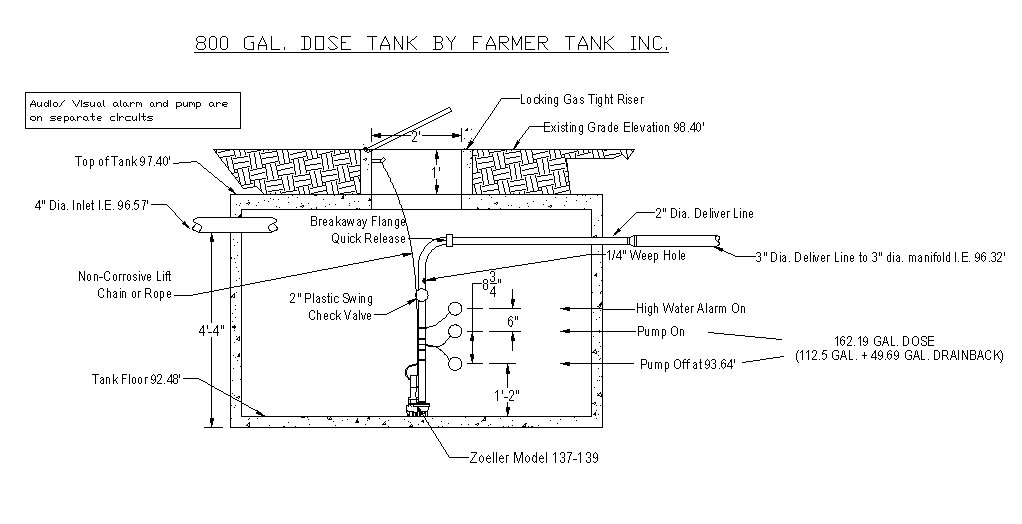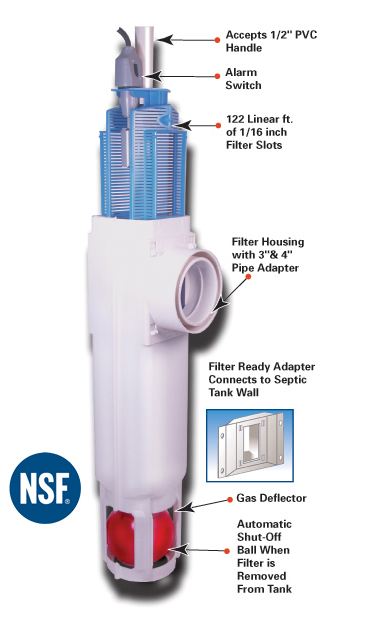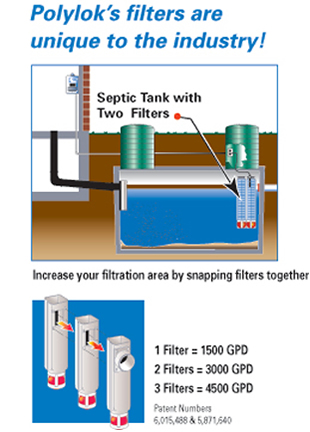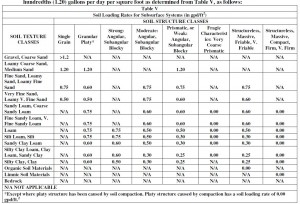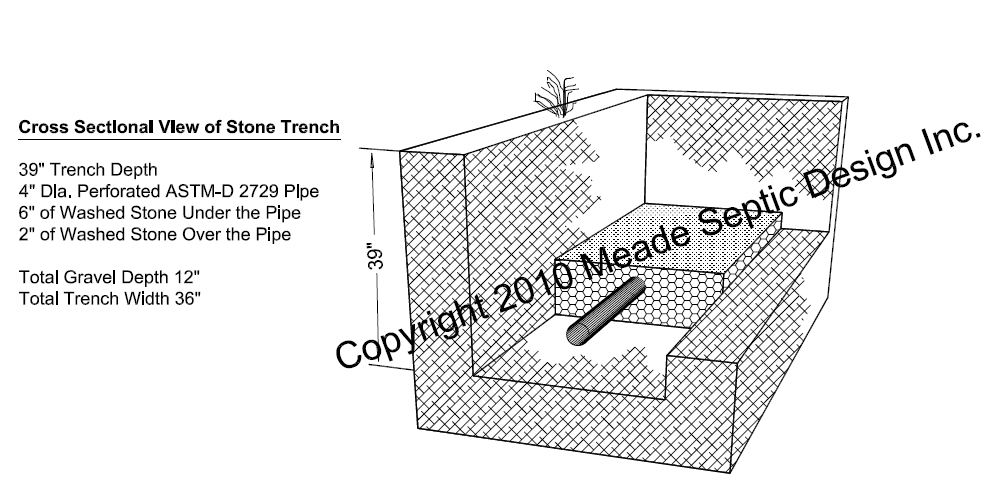TERMINOLOGY
A glossary of all the septic lingoTERMINOLOGY
Here is a list of some of the most common terms of Septic Design lingo.
ALTERNATING VALVE
An “alternating valve” or a “switching valve” refers to a device that allows you switch from one absorption field to the other in a gravity type septic system. The brand name of a popular valve is the Bull Run valve.
What are the benefits of two field?
Using one field at a time allows the other one to rest and dry out. This switching back and forth will help to prohibit a bio-mat growth in your absorption field and should make your system last exponentially longer (than if you had just one field).
I recommend switching your valve every year on a specific date like the fourth of July or first day of spring. If these dates don’t suit you, don’t be afraid of creating your own special date like “Were having a party to switch our septic day!”
Here is another way to manage your valve. Put on Valve on position 1 during odd years and position 2 during even years. I think the party idea is better.
Why would I have two absorption fields?
– When your system was installed, you might have had the wisdom and foresight to have two fields installed
– When you have a repair system installed, you may have enough room in your yard to keep the new and existing field separate. This is a great thing (like finding a box of perfectly good donuts on the side of the road)
– If you are putting a valve on a new and failed system. Switch the valve to the new system for three years. Then switch the alternating valve yearly to alternate between the two. Three years of rest will allow your failed system to regain as much of it’s absorption capacity as possible.
More about Meade Septic Design Inc. Services
View Meade Septic Design, Inc. Commercial Clients and Projects
Got septic system questions? Email me!
SludgeHammer TREATMENT AND SECONDARY TREATMENT
Secondary treatment (in the on-site septic industry) refers to a device that cleans your wastewater before it goes to your absorption field. Usually, this treatment device is installed downstream of your septic tank (prior to your septic absorption field or dosing tank) and treats the liquid effluent.
Secondary treatment benefits…
All regular septic absorption fields will fail over time. How long your system lasts is a function of the amount and strength of the wastewater you are putting into your system. It is generally understood how lots of water can stress your absorption system but the concept of waste strength is often under appreciated or not understood.
Over time, the soil surface at the bottom of your absorption field will develop a bio-mat (a layer of anaerobic bacteria) that grows into a jelly-type black mat that seals off the soil interface. This mat continues to grow and slows the rate of absorption, eventually causing the system fail (i.e. back up into your newly remodeled bathroom).
A secondary treatment device cleans your wastewater before it goes to your absorption field and can eliminate the existing bio-mat or keep it from forming in the first place. SludgeHammer secondary treatment cleans the wastewater through recirculation, aeriation and inoculation of their proprietary bacteria. The result is cleaned water rich in aerobic bacteria entering your absorption field.
There are many brands and types of secondary treatment systems that utilized different methods to clean your waste water. There are Aerobic treatment units, recirculating media and sand filters, and algae and plant based systems just to name a few.
My favorite is SludgeHammer from Petoskey Michigan. My joint venture company, Meade Septic Supply LLC, is now the principal distributor in Indiana.
I’ve designed many SludgeHammer engineered systems to handle high-strength waste in Indiana. Please contact me directly to find out more (574.215.9289) or visit the SludgeHammer website at https://sludgehammer.net/
BARRIER MATERIAL FOR SEPTIC SYSTEMS
Gravel trenches, mound system beds and perimeter drain aggregate all need to be covered with a barrier material that keeps the back-filled soil from penetrating down into the aggregate. In the past, this fabric has been called geo-textile fabric (in Indiana). Our new septic rule, 410 IAC 6-8.2, requires a heavier and stronger material.
View the Indiana State Department of Health’s list of approved manufacturers here: Interpretation_410_IAC_6-8-2-66_Barrier_Materials_11-03-11
The new rule states:
410 IAC 6-8.2-66 Barrier materials
Sec. 66. (a) Barrier material shall meet the following requirements:
(1) Be synthetic fabric, either spun bonded or woven.
(2) Have the following physical characteristics:
(A) A weight equal to or greater than three and one-tenth (3.1) ounces per square yard.
(B) A grab tensile strength equal to or greater than eighty (80) pounds.
(C) A grab tensile elongation less than or equal to fifty percent (50%).
(D) A trapezoid tear strength equal to or greater than thirty (30) pounds.
(E) A puncture resistance equal to or greater than thirty (30) pounds.
(F) A Mullen Burst equal to or greater than one hundred forty-five (145) pounds per square inch.
(G) A permittivity of less than or equal to 2.2 sec-1.
(H) A water flow rate less than or equal to one hundred fifty (150) gallons per minute per square foot.
(I) A UV resistance at five hundred (500) hours equal to or greater than seventy percent (70%) strength retained.
(3) Have the following chemical characteristics:
(A) Be nonbiodegradable.
(B) Be resistant to acids and alkalies within a pH range of 4 to 10.
(C) Be resistant to common solvents.
(b) Installation of barrier material shall meet the following requirements:
(1) For aggregate trenches and elevated sand mound aggregate beds, barrier material shall be placed on the aggregate to prevent soil particle movement into the aggregate.
(2) The barrier material shall cover the aggregate of aggregate trenches and elevated sand mound aggregate beds from side to side and from end to end.
BIOMAT
A bio-mat is a layer of slimy dark-grey colored bacteria that forms and lives in your absorption field. This bacteria can slow your systems ability to absorb water by physically clogging the soil interface.
Some bio-mat is normal and in fact healthy. When nutrient ladened wastewater passes through the bio-mat, it consumes some of the wastewater’s nutrients, partially cleaning the water before it passes into the soil. Hydraulically overloading and high strength flows will optimize growing conditions for the bio-mat and enable it to chock off your system.
Secondary Treatment devices are known to prevent bio-mats from forming or breaking up existing bio-mats by cleaning the nutrients from the wastewater before it goes into your absorption field. Existing bio-mats will literally starve and break up without the presence of nutrients. This is also a good reason to have an alternating valve on your system.
Keep your bio-mat at bay by doing the following:
- Minimize your water usage
- Don’t use garbage disposals (or at least use them sparingly)
- Never dump kitchen grease down the drain!
- Put your septic system (and bio-mat) on a diet by not feeding them unnecessary foods and liquids. High calorie foods like gravies, sauces, oils, cake batter, etc. all will significantly increase your wastewater strength (BOD) and promote an escalating and unwanted bio-mat.
Don’t want to take chances with a bio-mat? Install an SludgeHammer Treatment system. Contact me for details.
CHAMBER SEPTIC TRENCHES
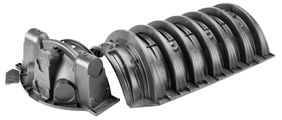
Infiltrator Standard Quick 4 Chamber
What is a septic chamber system?
Chambers are plastic domes that are used in septic system trenches instead of the traditional “pipe and stone” (gravel) trenches. There are a number of different manufacturers of septic chambers. Many excavators prefer using chambers over stone.
Chambers nest on top of each other for easy transport.
Here are some of the benefits of chambers over gravel:
- Easy to transport (stake in back of pickup truck)
- Lightweight
- A cleaner installation (no messy stone to clean up after wards)
- Higher storage capacity than stone (if you are putting water into the system faster than it can be absorbed into the ground)
- No need for a skid loader (often a Bobcat) to haul stone to trenches
- Look like something from Star Wars
Here are some of the drawbacks of chambers:
- More expensive than stone (typically)
- A pain to install when roots are protruding into the trench
- The trenches don’t breath as well as gravel trenches do (venting the chambers helps)
- Slightly limited trench configurations due to the way they connect to each other (cannot make harp 90 degree turns)
Update 01/29/09. Infiltrator has introduced a new line of “Plus Chambers” which includes a low profile unit that is only 8″ tall. The new inlet invert elevation is only 3.3″. More information on these units and Indiana’s approval of these unit by viewing the following PDF file. Infiltrator Quick 4 Plus
View Infiltrator’s Quick4 Plus Low Profile Chamber PDF
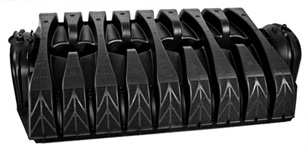
Infiltrator’s Quick4 Plus Low Profile
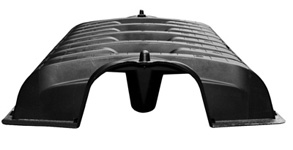
Infiltrator’s Quick4 Plus Low Profile (Note center column)
DISTRIBUTION BOX
A distribution box (or “D-Box” or “junction box”) is a concrete or plastic box that evenly splits the flow of effluent between absorption trenches. All distribution boxes have one inlet and multiple outlets. The inlet and outlets are designed for 4″ diameter pipes.
The picture of the D-box is made of concrete. The lid is shown above the box. Many of today’s distribution boxes are made of black plastic.
Ideally, the distribution box is installed perfectly level and on undisturbed ground. Being level keeps all the pipes inside the D-box at the same elevation promoting equal distribution of waste water to the trenches. The inlet pipe is typically 1″ higher than the outlets.
What is wrong with this D-box set-up?
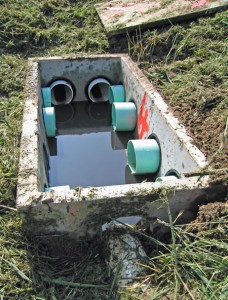
Improper D-box set up
The inlet pipe (lower part of the picture) was never properly connected to the D-box (see gap above pipe). In this case, the inlet pipe running up to the box is 3″ in diameter while the D-box inlet hole is 4″ diameter. To properly configure this inlet, the excavator needed to get a reducer fitting (4″ to 3″) to get a good seal at the Box inlet. Also, the inlet flow also must be baffled so that the flow does not favor one or more outlets. This is usually done with a tee or vented 90 degree elbow.
More about Meade Septic Design Inc. Design Services
View Meade Septic Design, Inc. Commercial Clients and Projects
Got septic system questions? Email me!
DOSING TANK
While not a “kind of septic system”, a dosing tank (or pump tank) is an integral part of any pumped septic system like a mound system or flood dose system. It is a tank (built like a septic tank ) that contains one or more effluent or sewage pumps, controls, etc. Float type control switches inside tank turn the pump on and off. The pump delivers a “dose” of water to the absorption field. Dosing tanks usually require a high water alarm to notify the owner in the case of a pump failure. Electrical connection should be made outside of the dosing tank and riser in a weather proof box. Gases inside the tank are very corrosive and will quickly destroy any exposed metal.
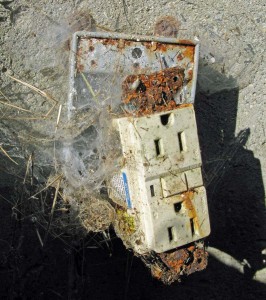
Electrical connection should be made outside of the dosing tank and riser in a weather-proof box.
Some septic system (i.e. mound type systems) require smaller doses of effluent while flood dose systems can accept larger doses. Dosing tanks are often required when an existing septic tank is too deep to accommodate a shallow trench repair system.
Saturated zones in a septic absorption fields promote the growth of anaerobic bacteria and a bio-mat. Bio-mats form at the soil interface. This is a normal thing in septic systems (and not all bad). However, when the biomat become substantial enough, it can slow and even stop your systems infiltration of wastewater and and cause your septic system to fail. Dosing tanks can help slow the formation of this biomat (and thus your system’s failure).
Gravel absorption trenches contain about 33 percent void space. This space allows your absorption trenches to store wastewater until it can be absorbed into the ground. A dosing tank can use this storage capacity to your advantage by pumping lots of water to your trenches just once a day. This allows your trenches to drain and rest in a well drained state prior to the next dose. This helps to eliminate these zones of constant saturation.
More about Meade Septic Design Inc. Design Services
View Meade Septic Design, Inc. Commercial Clients and Projects
Got septic system questions? Email me!
DRY WELLS
What’s a drywell?
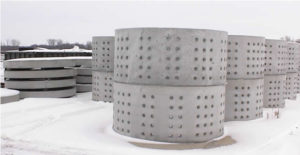
Drywells are perforated concrete cylinders
A drywell is a type of absorption system (remember that a septic system is made up of a septic tank and then some sort of absorption system).
A drywell is usually a tall concrete cylinder with holes in the side and an open bottom (see above).
Drywell installation and how they work
Drywells are installed by digging a deep hole, usually near the septic tank, and setting the drywell in it. Gravel is usually dumped around the outside of the drywell and a lid put on top.
The drywell is then connected to the septic tank with piping (tile) and the whole thing is covered with soil. Effluent enters the drywell from the septic tank and then exits out the holes in the side and seeps into the soil that surrounds it..
Drywells were also constructed of brick. These were built as upside-down cone shaped structures constructed inside a large hole. Once completed, they were carefully covered up with soil (backfilled). Some have small lids at the top of this cone. This lid is often accessible from the ground surface for pumping, visual inspections or just gazing into for sheer delight.
I have had the pleasure of peering into many of these masonry marvels, some of which are ten feet deep and eight feet across at the bottom. This homemade variety has been known to cave in, sometimes swallowing garden tractors and their riders!
NOT a recommended activity (low fun factor).
Nowadays, drywells are seldom installed for use in septic systems but are often used in parking lots for the disposal of surface water. However, many drywells are still used in existing septic systems. Drywells don’t usually make up the entire field absorption system but instead are used in conjunction with other types of absorption fields like trenches.
No longer the chosen disposal method
Drywells are no longer legal to install in Indiana. Studies have shown that drywells have been big contributors to polluting the groundwater. Many of them were installed in sandy soils with high water tables. This allows the effluent to move directly into the ground water instead of first being treated by well drained soils. Ouch.
Dry wells are often set in parking lots to drain away surface water.
About Meade Septic Design Inc. Design Services
View Meade Septic Design, Inc. Commercial Clients and Projects
Got septic system questions? Email me or ask them at the Forum!
EFFLUENT AND SEWAGE PUMPS
Effluent and Sewage Pumps are wastewater pumps manufactured specifically to pump.. well… wastewater.
These pumps are used in dosing tanks (pump tanks) for residential and commercial septic systems.
Effluent pumps are able to pass about 1/2″ solids, while sewage pumps can often pass 2″ solids! Either can be used in effluent pumping applications.
Be sure to consult a septic professional to make sure you’re getting the right size pump. Undersized pumps are sure to break. Over sized pumps might blow apart your system components.
They are different than your run-of-the-mill hardware store sump pump in a couple of ways.
- Effluent/sewage pumps are built to handle some solids
- Effluent/sewage pumps are constructed of heavy duty materials to withstand the corrosive atmosphere of the dosing tank
- Effluent/Sewage pumps are usually much more powerful than sump pumps
- They cost more!
Most effluent and sewage pumps will last at least five years. Some will even last 10-14 years! Your mileage may vary.
Some popular manufacturers of Effluent and Sewage Pumps are:
Zoeller Pumps
More about Meade Septic Design Inc. Services
View Meade Septic Design, Inc. Commercial Clients and Projects
Got septic system questions? Email me!
EFFLUENT FILTER
Effluent Filters are a simple and cost effective way to keep your system working properly and are now required in Indiana under 410 IAC 6-8.2.
Filters help to prevent suspended “stuff” (like hair and other solids) from leaving your septic tank and clogging up your absorption field. An effluent filter mounts on your septic tank’s outlet or inside the outlet’s tee. All water that exits the tank must first pass through the filter. Most filters are made of plastic with 1/16th inch to 1/8th inch filter slots.
Servicing an effluent filter is simple. It usually means removing the filter from the tank and spraying it off with a garden hose.
This may need to be done as often as every six months or be able to operate fine for years, depending on the conditions in your tank and your wastewater flow. Septic pumpers will service and/or replace your filter when they come out to clean your tank.
Indiana’s septic rule 410 IAC 6-8.2 (effective January 1, 2011) requires effluent filters (that meet ANSI/NSF 46 Standards) in tanks on new construction projects. These filters must be rated at 1.5 times the capacity of the septic tank. This means that a three bedroom house with a 1000 gallon septic tank must be equipped with an effluent filter that is rated at 1,500 gallons per day.
If multiple tanks are used in series, the effluent filter should be installed on the outlet side of the last tank. The Indiana septic rule also gives county health departments the option to require them in repair situations (where existing tanks are used in conjunction with new absorption fields).
The drawback to most effluent filters is that they can actually cause more harm than good unless they’re serviced on a regular basis (maintained by cleaning). If neglected, most effluent filters plug up and greatly restrict the flow leaving the tank. This eventually causes a high water level in your tank and backups in your plumbing. If a plugged filter causes a backup in your system, be sure to have your tank pumped down BEFORE you remove your filter. Pulling your filter while there is a high water level in your tank will cause effluent, scum, grease and LOTS of suspended solids to get washed out into your absorption field – this is bad! To keep this from happening, you must pump the tank down (at least to the normal operating level) before you pull the filter.
The following is a picture of a PL-122 Effluent Filter System by Polylok Inc. This is a great effluent filter that it NSF 46 approved, rated for 1,500 gpd, and approved in Indiana for 1000 gal. septic tanks. The filters can be snapped together to increase filtration capacity(see below). The red ball on the bottom makes a water tight seal when the filter is pulled and prevents water and scum from rushing out of the tank if the filter is pulled when the water is high (as described above).
Meade Septic Design Inc. sells the Polylok PL-122 filter for $50. Call me to order yours 574-533-1470.
LIQUID EFFLUENT
Effluent is the liquid wastwater that forms in the central part of your septic tank.
The baffle on your septic tank outlet should only allow effluent to move from your septic tank to your absorption field. The sludge and scum layers should be left behind and be pumped out every 3-5 years.
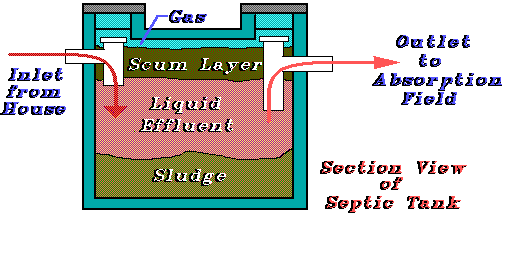
Liquid Effluent in central part of septic tank
More about Meade Septic Design Inc. Design Services
View Meade Septic Design, Inc. Commercial Clients and Projects
Got septic system questions? Email me!
PERIMETER DRAIN
Perimeter Drains and Curtain Drains:
A curtain drain is a drain used to intercept water moving though the soil. The term “perimeter drain” describes a curtain drain that surrounds an area, making a complete circuit. Perimeter drains are sometimes installed around septic absorption fields to help drain wet soils (absorption fields need well drained soils to function properly).
Perimeter drains usually connect (outlet) to existing field tiles, open ditches or to the ground surface on the side of a slope.
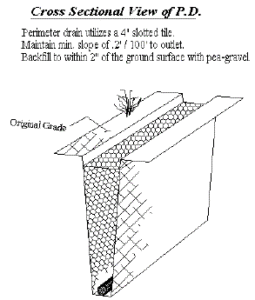
Cross section of a perimeter drain
How a perimeter drain is installed:
-
- A trench is dug where the drain is to be installed (usually at least 10′ from the absorption field).
- A slotted field tile is laid in the trench bottom (the tile is usually 4″ – 6″ in diameter). The tile must maintain a minimum slope (usually .2’/100′) throughout its length until the point of its outlet.
- The trench is then filled nearly to the ground surface with gravel (usually pea-stone).
- The drain is then covered with fill soil.
SEPTIC TANK
What is a septic tank?
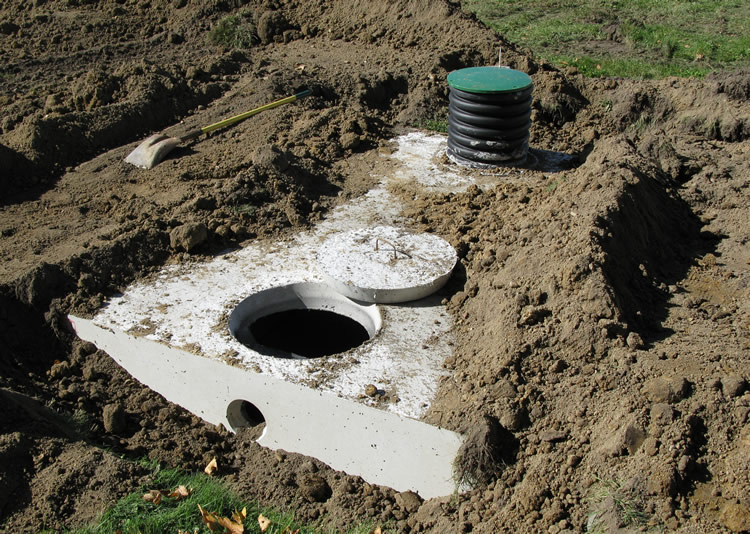
Modern Septic Tank with access riser
A septic tank is a buried, watertight container usually made of concrete. It holds the wastewater long enough for bacteria digestion and settling to occur. In a properly working tank, the contents of the tank will separate into three distinct layers.
1. Sludge on the bottom of the tank
2. A liquid effluent layer in the center part of the tank
3. A scum layer, made of oils and fats at the very top of the tank (Yum!)
To keep the tank from getting agitated (or stirred up), the inlet flow needs to be baffled. This is usually accomplished by a concrete baffle (as part of the tank) or a PVC tee fitting on the inlet pipe.
The outlet pipe is on the other end of the tank. The outlet pipe is equipped with a tee fitting that extends down into the liquid (middle) portion of the tank. This allows only the liquid effluent to leave the tank and enter the absorption field.
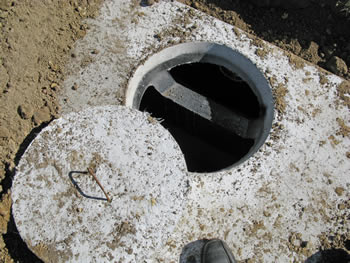
Concrete Inlet Baffle
Effluent filters are often installed on the outlet side of the tank to help keep any residual suspended “Stuff” from leaving the tank.
A “dead tank” or blackwater tank describes an unhealthy septic tank where there are NOT distinct layers inside the tank. This can be caused by medications, softener discharge or hydraulic overloading of your septic system (too much water).
If you have a “Dead tank”, your effluent filter will clog up immediately, making you aware of the problem
before all those suspended solids make there way to your absorption field and do damage!
Effluent filters are inexpensive and are always a good idea.
Existing “septic tanks” are often inadequate and made out of bricks, metal or even wood. Many of these old septic tanks are grossly undersized and structurally unsound (dangerous).
Below is an example of crock style septic tanks. These tanks are set in series. These are only 24″ in diameter. I found them at an old two bedroom farm house.
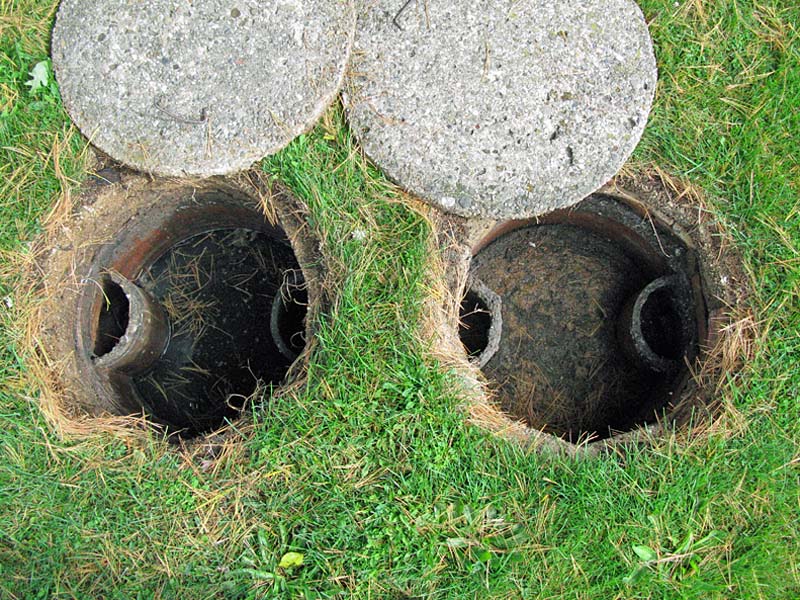
Crock Septic Tank(s). Note baffles on inlets and outlets
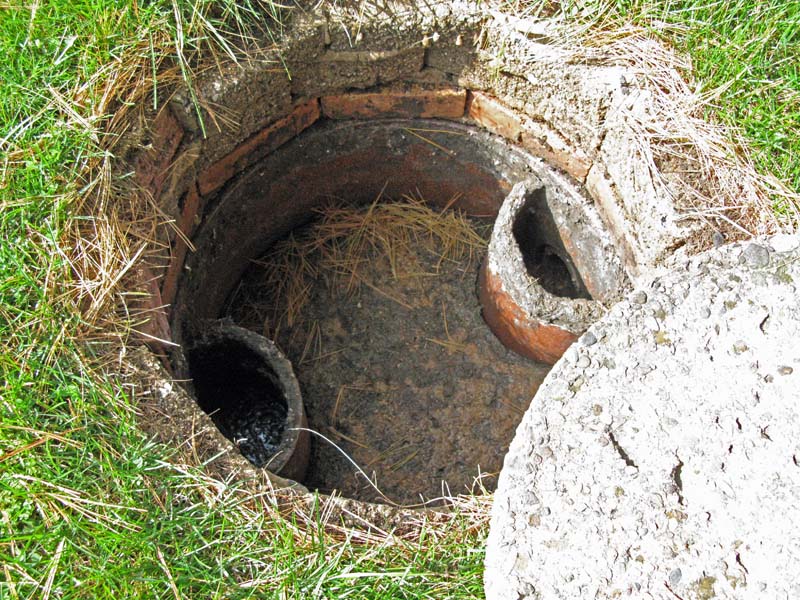
Close-up of Crock septic tank construction
Related:
How to find your septic tank and Septic Care pages
More about Meade Septic Design Inc. Design Services
View Meade Septic Design, Inc. Commercial Clients and Projects
Got septic system questions? Email me!
SIM TECH PRESSURE FILTER
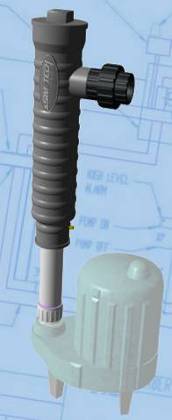
Sim Tech Pressure Filter
Meade Septic Design Inc. recommends the use of Sim Tech Pressure Filters in dosing tanks that pump to pressure distribution systems (such as Mound Systems).
Hair and other suspended debris can clog the small 1/4″ holes in pressure distribution laterals. This can lead to unequal distribution of effluent and eventually failure of the absorption field. Sim Tech pressure filters, taking advantage of the cyclone action created by the pump, utilize a stainless steel screen and sock filter to trap the debris with almost undetectable affects on flow. Sim Tech recommends that drainback be allowed to flow through their filter. This allows for a backwashing action which partially cleans the filter after each dose.
High flow rates may require two 2″ dia. filters in parallel.
Sim Tech recommends inspecting and replacing the filter sock every 6 months. Some systems may be able to go one year between servicing.
Sim Tech filters can be purchased from many local concrete precastors. Watch the below video to see it in action.
I carry a demonstration model with me. Ask to see it when we meet (if I forget to show it to you).
SOIL LOADING RATES – SEPTIC SYSTEM SIZING
How are septic systems sized?
Soil loading rates are numbers that describe the rate that effluent water is expected to penetrate a soil. Loading rates are expressed in gallons per day / square foot. Soil texture and structure are both considered when determining the soil loading rates. Click the below graphic to see Indiana’s Loading Rate Chart for Subsurface septic systems.
The soil loading rate is used to calculate the size of the septic system using the following equation.
Design Daily Flow / Soil Loading Rate = Square Footage of Trench Required
System Sizing Example:
Three Bedroom House (3 bedrooms x 150 gpd/bedroom) = 450 gpd flow
Fine Sand Soil Texture = Loading rate of .75 gpd/sq. ft. moderate structure
450 divided by .75 = 600 sq. ft. absorption field
Indiana Septic Code 410 IAC 6-8.2 defines Loading Rates as:
Sec. 43. “Soil loading rate” means the allowable rate of application of septic tank effluent to the soil. It is
expressed in gallons per day per square foot. (Indiana State Department of Health; 410 IAC 6-8.2-43)
STONE SEPTIC TRENCH
What is a gravel septic trench?
All septic systems have some type of absorption field used to dispose of wastewater (effluent) through absorption into the ground. Gravel (stone) trenches are the most common type of absorption field.
In Indiana, trenches bottoms are dug level and then back-filled with stone and a perforated pipe.
Click Below to See Sample Drawing:
Septic System Gravel Trench
TIRE CHIPS IN SEPTIC SYSTEMS
The use of tire chips (also known as rubber rock) in septic systems, as an alternative to stone, has become a common practice. Tire chips are cheap, lightweight (meaning they are easier than stone to transport) and are a great way to recycle old tires. Locally, tire chips are available from Entech in White Pigeon Michigan.
The Indiana State Department of Health allows the use of tire chips. See the link below to read their policy.
Indiana State Department of Health Tire Chip Guidance Letter

Photo by Mark Lebryk
